| Titles in Print | |
| Standard Reference Works | |
 | Standard Tibetan Grammar: Volume I, The Thirty Verses of Minister Thumi by Tony Duff |
 | Standard Tibetan Grammar: Volume II, The Application of Gender Signs by Tony Duff |
| The Sources: Tibetan Grammar Texts | |
 | The Great Living Tree Grammars for Beginners |
 | Situ's Words by Ngulchu Dharmabhadra |
 | Essence of Situ's Elegant Thorough Explanation by Khenpo Ngedon Jamyang |
 | Application of Gender Signs Clarified; advanced Tibetan grammars by Yangchen Drubpay Dorje |
| Other Grammar Publications | |
 |
A number of publications which show how to apply Tibetan grammar to the translation of Tibetan texts are available on our free texts pages. |
Full Descriptions of Titles in Print
| Title | Standard Tibetan Grammar Volume I, The Thirty Verses of Minister Thumi |
| Author | Tony Duff |
| Details | 834 pages, 6" X 9" (larger book size), US$120, available in e-book (PDF) format |
| ISBN | paper book 978-9937-572-35-4, e-book 978-9937-572-14-9 |
| Texts | Seven Tibetan texts included (see listing below) |
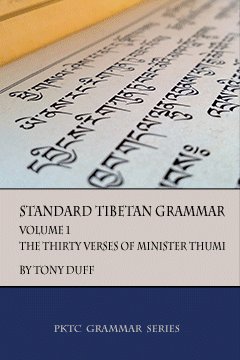 This is Lotsawa Tony's magnum opus. He started writing it in the late 1990's and has been letting
it mature since. He has been in no hurry to publish it because he intends it to be the standard
reference for Tibetan grammar for the foreseeable future. The complete work is envisaged as a series
of volumes. For the other volumes, see below.
This is Lotsawa Tony's magnum opus. He started writing it in the late 1990's and has been letting
it mature since. He has been in no hurry to publish it because he intends it to be the standard
reference for Tibetan grammar for the foreseeable future. The complete work is envisaged as a series
of volumes. For the other volumes, see below.Although there are a number of books available on Tibetan grammar, all of them come from a Western approach and not one of them shows the actual meaning of Tibetan grammar as understood by Tibetans. This book corrects that completely. It offers commentary and background written by a Westerner who has studied Tibetan grammar in Tibetan classes in a purely Tibetan milieu and couples that with authentic translations of several of the most important Tibetan grammar texts.
The first volume begins with extensive historical background, far more than seen in any other Western publication, and includes selections from various Tibetan history texts not to mention the fruits of the author's own, considerable research during the many years that he has lived in Nepal.
The book continues with a major exposition of the lineages of grammar and the main texts used for the study of Tibetan grammar. Again, none of this information has been seen to date in Western publications.
The book continues with a history of the three language revisions. This completes the prefatory sub-volumes.
The real material of the book starts with Thumi's first grammar treatise, The Root of Grammar in Thirty Verses. This is the first authoritative translation of the text into English. The treatise is followed by hundreds of pages of explanation that show every single nuance and detail of the text, all written by the author. This explanation includes a wealth of detail that shows how Tibetan grammar works in its own right and also shows how it can or cannot be related to English grammar. This section of the book is a treasure trove of information for any translator, covering many points of Tibetan grammar and its relationship with translation into English which are essential for any translator to know.
Included within the author's extensive explanation is a very long chapter on pronunciation. This is one subject that is still not being taught properly even in major programs around the world. The reason is simply that very few Westerners have understood all the details involved in Tibetan pronunciation. The author not only includes those details but uses extensive quotations from the Tibetan sources to show how it does work. The first translation ever of a Tibetan text on pronunciation is included in the book.
Also included is an investigation of the hottest debate in Tibetan grammar, the debate over how many vowels there are in the language. The author presents the opinions of many great Tibetan scholars of the past including Thumi Sambhota, Sakya Pandita, Situ Panchen, and others. The complete section on this issue taken from Situ's very famous Great Commentary on grammar has been translated and included. This is not only interesting in its own right but provides a glimpse of this famous grammar text.
There are chapters that explain where the nouns, verbs, adverbs, and adjectives of English grammar can and cannot be found in Tibetan grammar. There are chapters which explain punctuation and how it works and where one could find English punctuation or not within Tibetan punctuation. A long list of the many punctuation marks in the Tibetan language with explanations is also included.
The book contains translations of the following texts:
 | The Root of Grammar, The Thirty Verses by Thumi Sambhota |
 | "The Great Living Tree", The Essence of Thonmi's Fine Explanation The Thirty by Yangchen Drubpay Dorje |
 | "The Fine Explanation Great Living Tree", The Clarifier of the Meaning of The Essence of "The Thirty" by Yangchen Drubpay Dorje |
 | "Supreme Expert Situ's Words", A Thorough Explanation of the Grammar Shastras of the Language of the Snowy Land, The Thirty and Application of Gender Signs by Ngulchu Dharmabhadra (PART I about the Thirty Verses only) |
 | The Essence of the Elegant "Thorough Explanation", The Literal Aspect of the Snowy Land's Grammar Shastras, The Thirty and Application of Gender Signs by Khenpo Ngedon Jamyang (PART I about the Thirty Verses only) |
 | "A Beautiful String of Pearls to Adorn the Necks of the Wise", A Thorough Explanation of the Specific Texts The Thirty and Application of Gender Signs of the Shastras that Authentically Set Forth the Signs of the Snowy Land by Situ Chokyi Jungney (Section on vowel definitions only) |
 | A New Bud of the Story Of How The Production Places, Producers, And Efforts of Tibetan Letters Are Identified by Yangchen Drubpay Dorje (a text on the Tibetan system of pronunciation) |

| Title | Standard Tibetan Grammar Volume II, The Application of Gender Signs |
| Author | Tony Duff |
| Details | 250 pages, 6" X 9" (large book size), US$85, available in e-book (PDF) format |
| ISBN | paper book 978-9937-572-36-1, e-book 978-9937-572-37-8 |
| Texts | Four Tibetan texts included (see listing below) |
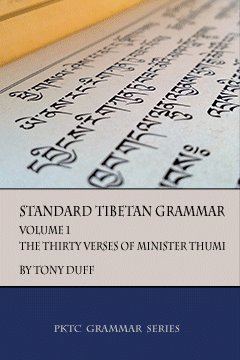 This is the second volume of Tony's magnum opus. He started writing it in the late 1990's and has been
letting it mature since. He has been in no hurry to publish it because he intends it to be the standard
reference for Tibetan grammar for the foreseeable future.
This is the second volume of Tony's magnum opus. He started writing it in the late 1990's and has been
letting it mature since. He has been in no hurry to publish it because he intends it to be the standard
reference for Tibetan grammar for the foreseeable future.This second book is the second in a series of volumes. For the other volume, see above.
Although there are a number of books available on Tibetan grammar, all of them come from a Western approach and not one of them shows the actual meaning of Tibetan grammar as understood by Tibetans. This book corrects that completely. It offers commentary and background written by a Westerner who has studied Tibetan grammar in Tibetan classes in a purely Tibetan milieu and couples that with authentic translations of several of the most important Tibetan grammar texts.
The second volume focusses on Thumi Sambhota's second, extant treatise which defines Tibetan grammar. This treatise concerns the specific issue of what is called "letter gender". The text defines letter gender then shows its various effects. The text is extremely difficult to understand, so difficult that many well-educated Tibetans do not study it. To make the material of the treatise more accessible, the book starts with an overview of the whole treatise which goes into sufficient detail that the general points of the treatise can be understood fairly easily. The book then continues with in-depth commentaries on the various effects of letter gender, going through the points that are found in the treatise itself. There are several main effects such as pronunciation, verb theory, and phrase linker theory. The book gives detailed and extensive explanations of verb theory. The book especially gives a complete explanation of the Tibetan system of transitive verbs and intransitive verbs. For the first time, the special self-and-other feature of transitive verb theory is explained fully yet exactly according to the Tibetan system. All of these explanations are given so clearly so that anyone will be able to understand these various difficult points as they are called, of the treatise. This is the first time that a complete and clear explanation of this treatise and its difficult points has appeared in English.
The book contains translations of the following texts:
 | Grammar, "The Application of Gender Signs" by Thumi Sambhota |
 | "A Mirror Which Reveals the Difficult Points", A Short Statement of the Essential Meaning of The Application of Gender Signs by Yangchen Drubpay Dorje |
 | "A Golden Key of Knowledge", Commentary to A Mirror that Reveals the Difficult Points of 'The Application of Gender Signs' by Yangchen Drupbpay Dorje |
 | "Supreme Expert Situ's Words", A Thorough Explanation of the Grammar Shastras of the Language of the Snowy Land, The Thirty and Application of Gender Signs by Ngulchu Dharmabhadra (PART II about the Application of Gender Signs only) |
 | The Essence of the Elegant "Thorough Explanation", The Literal Aspect of the Snowy Land's Grammar Shastras, The Thirty and Application of Gender Signs by Khenpo Ngedon Jamyang (PART II about the Application of Gender Signs only) |

| Title | The Great Living Tree Tibetan Grammars |
| Sub-title | Beginner's Level Tibetan Grammar Texts by Yangchen Drubpay Dorje |
| Author | Tony Duff |
| Details | 132 pages, 6" X 9", US$20, available in paper book and PDF e-book formats |
| ISBN | paper book 978-9937-572-32-3, e-book 978-9937-572-31-6 |
| Texts | Tibetan texts in Tibetan script included (see listing below) |
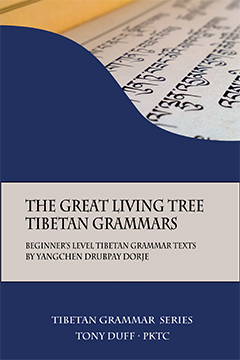 In the seventh century C.E. the Tibetan man Thumi Sambhota wrote eight treatises that defined Tibetan grammar and lettering, but only two of them still exist, the others have been lost about two centuries after they were composed. Of the eight treatises, the first one, called The Root of Grammar, The Thirty Verses, and the sixth one, called The Application of Gender Signs, still exist.
In the seventh century C.E. the Tibetan man Thumi Sambhota wrote eight treatises that defined Tibetan grammar and lettering, but only two of them still exist, the others have been lost about two centuries after they were composed. Of the eight treatises, the first one, called The Root of Grammar, The Thirty Verses, and the sixth one, called The Application of Gender Signs, still exist.The book here presents a pair of Tibetan grammar texts that were written for beginners. Together, they show the meaning of the first of the eight defining treatises in a very basic way. They do not speak about the sixth treatise because the sixth treatise is very difficult to understand and not for beginners. The pair of texts was written over two centuries ago, but the two texts were so well-suited to their intended purpose that they were immediately adopted and have been used since that time for teaching the basics of Tibetan grammar to Tibetans. For example, they are still used in Tibetan schools and Tibetan Buddhist monasteries in Tibet, India, and Nepal as the basis for teaching grammar to Tibetan children. Of the pair of texts, the first one is a very short text that was written for ease of memorization. The second one gives easy-to-understand explanations of the first text so that it can be more clearly understood.
Non-Tibetans will need more help with understanding the pair of texts, so the author of this book, an accomplished Tibetan grammarian in his own right, has written a third text to add to the first two. The third text provides guidance on the meaning of the first two texts written in easy-to-understand English that makes the original pair of Tibetan texts much easier to follow. In addition, the Tibetan texts in Tibetan script have been included in the book for those who would like to study grammar in more depth.
This book is an ideal way for non-Tibetans to begin learning Tibetan grammar using the same textbooks as beginning Tibetan students themselves use. It is also a way to discover what is in a native Tibetan grammar text in general and especially it shows how Tibetans understand their own grammar. For those wanting something more advanced there are other books from us that present a number of the most important native Tibetan grammar texts. A really thorough explanation of everything contained in any of these other books can be found in our two standard reference works on Tibetan grammar, Standard Tibetan Grammar Volume I, The Thirty Verses of Minister Thumi and Standard Tibetan Grammar Volume II, The Application of Gender Signs.
The book contains translations of the following texts:
 | "The Great Living Tree", The Essence of Thonmi's Fine Explanation The Thirty |
 | "The Fine Explanation Great Living Tree", The Clarifier of the Meaning of The Essence of "The Thirty" |
 | "The Guidance Great Living Tree", A Guide to Yangchen Drubpay Dorje's Great Living Tree Texts |

| Title | Tibetan Grammar: Situ's Words |
| Sub-title | A Medium to Advanced Level Tibetan Grammar Text by Ngulchu Dharmabhadra |
| Author | Tony Duff |
| Details | 192 pages, 6" X 9", US$25, available in paper book and PDF e-book formats |
| ISBN | paper book 978-9937-572-34-7, e-book 978-9937-572-33-0 |
| Texts | Tibetan texts in Tibetan script included (see listing below) |
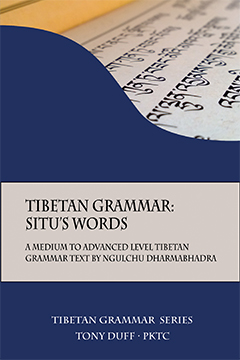 In the seventh century C.E. the Tibetan man Thumi Sambhota wrote eight treatises that defined Tibetan grammar and lettering, but only two of them still exist, the others have been lost about two centuries after they were composed. Of the eight treatises, the first one, called The Root of Grammar, The Thirty Verses, and the sixth one, called The Application of Gender Signs, still exist.
In the seventh century C.E. the Tibetan man Thumi Sambhota wrote eight treatises that defined Tibetan grammar and lettering, but only two of them still exist, the others have been lost about two centuries after they were composed. Of the eight treatises, the first one, called The Root of Grammar, The Thirty Verses, and the sixth one, called The Application of Gender Signs, still exist.The eighth Situ, Chokyi Jungnay, who is regarded as one of the best Tibetan grammarians who has lived, wrote a very large commentary to Tibetan grammar that became a standard amongst learned Tibetans. However, it is very complicated and not at all easy to understand. Ngulchu Dharmabhadra was another master grammarian who lived at the same time as Situ Chokyi Jungnay. He fully accepted Situ Chokyi Jungnay's approach to grammar, but saw that a text with the meaning of Situ's great grammar but without all the difficult argument in the great grammar was needed. Therefore, he wrote the text that is presented in this book and, appropriately, called it "The Supreme Expert Situ's Words". His text includes complete explanations of both of the existing grammars of Thumi Sambhota. Therefore his text and this book which presents it in English is an excellent text for those who want a medium to advanced Tibetan grammar text but do not need all the complexities that found in Situ's large tome on Tibetan grammar.
After Ngulchu Dharmabhadra had completed "Situ's Words", he told his nephew cum student that there was a need for a beginner's level Tibetan grammar text that beginners and ordinary Tibetans could easily learn from, and told him to write such a text. The result was the "Great Living Tree" pair of texts which we have published in a separate book. The "Great Living Tree" grammar texts are beginner's texts and, unlike Situ's Words, do not contain an explanation of the very difficult to understand sixth defining grammar treatise called The Application of Gender Signs.
Situ's Words has good explanations but there are many points that need further clarification. For that, the author of this book, himself an accomplished Tibetan grammarian, has provided many footnotes and a complete glossary of grammar terms. In addition, the Tibetan texts in Tibetan script have been included in the book for those who would like to study grammar in more depth.
The author of this book, who is well-known as an exceptionally capable translator of Tibetan Buddhism, has been concerned for many years at the mistaken translations of Tibetan Buddhism that arise because of a lack of understanding of the details of Tibetan grammar that exists amongst western translators. Therefore, he has published this and the other books on native Tibetan grammar in this series with a strong desire to make the Tibetan understanding of Tibetan grammar readily available. The end aim of course is that the western students studying Tibetan Buddhism will be able to gain a complete and correct understanding of the system through better translations of Tibetan works.
The book contains a translation of the following text:
 | "Supreme Expert Situ's Words", A Thorough Explanation of the Grammar Shastras of the Language of the Snowy Land, The Thirty and Application of Gender Signs by Ngulchu Dharmabhadra |

| Title | Tibetan Grammar: The Essence of Situ's Elegant Explanation |
| Sub-title | A Medium Level to Advanced Level Grammar Summarizing Situ's Great Commentary |
| Author | Text by Khenpo Ngedon Gyatso, book by Tony Duff |
| Details | 216 pages, 6" X 9", US$25, available in paper book and PDF e-book formats |
| ISBN | paper book 978-9937-572-30-9, e-book 978-9937-572-29-3 |
| Texts | Tibetan texts in Tibetan script included (see listing below) |
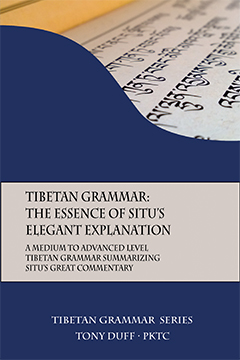 In the seventh century C.E. the Tibetan man Thumi Sambhota wrote eight treatises that defined Tibetan grammar and lettering, but only two of them still exist, the others have been lost about two centuries after they were composed. Of the eight treatises, the first one, called The Root of Grammar, The Thirty Verses, and the sixth one, called The Application of Gender Signs, still exist.
In the seventh century C.E. the Tibetan man Thumi Sambhota wrote eight treatises that defined Tibetan grammar and lettering, but only two of them still exist, the others have been lost about two centuries after they were composed. Of the eight treatises, the first one, called The Root of Grammar, The Thirty Verses, and the sixth one, called The Application of Gender Signs, still exist.The eighth Situ, Chokyi Jungnay, who is regarded as one of the best Tibetan grammarians who has lived, wrote a very large commentary to Tibetan grammar that became a standard amongst learned Tibetans. However, it is very complicated and not at all easy to understand. Ngulchu Dharmabhadra wrote an explanation of Thumi Sambhota's two existing treatises that followed Situ's great commentary on grammar but left out all of the extensive and often difficult-to-understand argument that Situ presented in his great commentary. Ngulchu Dharmabhadra's text, called Situ's Words, became a standard reference in Tibet for those wanting a medium to advanced explanation of Tibetan grammar. About one hundred years later, one of the khenpos at Karmapa's seat in Tibet, Khenpo Ngedon Jamyang, was asked to write a text on grammar for use in the monasteries of the Karma Kagyu tradition. His text did not become as popular as Situ's Words, but it has a little more detail in it, which is why we have translated it and published it in this book. Khenpo Ngedon Jamyang titled his text "Essence of the Elegant Thorough Explanation". The words "Elegant Thorough Explanation" in the title refer to Situ Chokyi Jungnay's great explanation of grammar and the word "essence" means that he has written an abridged version of Situ's great grammar that expresses its essential meaning.
Like Situ's Words, this is an excellent text for those who want something more than a beginner's text but who do not need all the complexities that come in large tomes on Tibetan grammar. We would recommend purchasing Situ's Words first and then purchasing this after, if you wanted to know still more about Tibetan grammar from a Tibetan perspective.
Khenpo Ngedon Jamyang's text has good explanations but there are many points that need further clarification. For that, the author of this book, himself an accomplished Tibetan grammarian, has provided many footnotes and a complete glossary of grammar terms. In addition, the Tibetan texts in Tibetan script have been included in the book for those who would like to study the grammar in depth.
The author of this book, who is well-known as an exceptionally capable translator of Tibetan Buddhism, has been concerned for many years at the mistaken translations of Tibetan Buddhism that arise because of a lack of understanding of the details of Tibetan grammar that exists amongst western translators. Therefore, he has published this and the other books on native Tibetan grammar in this series with a strong desire to make the Tibetan understanding of Tibetan grammar readily available. The end aim of course is that the western students studying Tibetan Buddhism will be able to gain a complete and correct understanding of the system through better translations of Tibetan works.
The book contains a translation of the following text:
 | The Essence of the Elegant "Thorough Explanation", The Literal Aspect of the Snowy Land's Grammar Shastras, The Thirty and Application of Gender Signs by Khenpo Ngedon Jamyang |

| Title | Tibetan Grammar: The Application of Gender Signs Clarified |
| Sub-title | Advanced Tibetan Grammars by Yangchen Drubpay Dorje |
| Author | Tony Duff |
| Details | 200 pages, 6" x 9", US$25, available in paper book and PDF e-book formats |
| ISBN | paper book 978-9937-572-28-6, e-book 978-9937-572-27-9 |
| Texts | Tibetan texts in Tibetan script included (see listing below) |
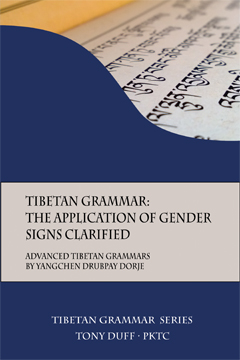 In the seventh century C.E. the Tibetan man Thumi Sambhota wrote eight treatises that defined Tibetan grammar and lettering, but only two of them still exist, the others have been lost about two centuries after they were composed. Of the eight treatises, the first one, called The Root of Grammar, The Thirty Verses, and the sixth one, called The Application of Gender Signs, still exist.
In the seventh century C.E. the Tibetan man Thumi Sambhota wrote eight treatises that defined Tibetan grammar and lettering, but only two of them still exist, the others have been lost about two centuries after they were composed. Of the eight treatises, the first one, called The Root of Grammar, The Thirty Verses, and the sixth one, called The Application of Gender Signs, still exist.The sixth treatise is very difficult to understand, to the point that even well-educated Tibetans often have not studied and learned it. Yangchen Drubpay Dorje was a great Tibetan grammarian of the 19th century who wrote a short text that summarized the meaning of Thumi Sambhota's Application of Gender Signs treatise. It was intended for easy memorization and needed explanation, so he wrote a text to explain it. Together, the two texts go through the various topics of Thumi's sixth treatise in depth. The two texts are the most popular ones in use these days for understanding the topic of application of gender signs. Amongst other things, these texts deal with the subject of transitive and intransitive verbs and how they work in the Tibetan language. It is essential for translators to understand the details of transitive and intransitive verbs, so this book is of special importance for translators.
The material in these texts is difficult, so there are many points that need clarification. For that, the author of this book, himself an accomplished Tibetan grammarian, has provided many footnotes and a complete glossary of grammar terms. In addition, the Tibetan texts in Tibetan script have been included in the book for those who would like to study grammar in more depth.
The author of this book, who is well-known as an exceptionally capable translator of Tibetan Buddhism, has been concerned for many years at the mistaken translations of Tibetan Buddhism that arise because of a lack of understanding of the details of Tibetan grammar that exists amongst western translators. Therefore, he has published this and the other books on native Tibetan grammar in this series with a strong desire to make the Tibetan understanding of Tibetan grammar readily available. The end aim of course is that the western students studying Tibetan Buddhism will be able to gain a complete and correct understanding of the system through better translations of Tibetan works.
The book contains translations of the following texts:
 | "A Mirror Which Reveals the Difficult Points", A Short Statement of the Essential Meaning of The Application of Gender Signs by Yangchen Drubpay Dorje |
 | "A Golden Key of Knowledge", Commentary to A Mirror that Reveals the Difficult Points of ‘The Application of Gender Signs' by Yangchen Drupbpay Dorje |